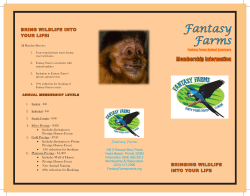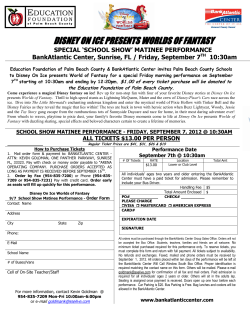
Fantasy Stories with elements that violate the natural, physical laws
Fantasy Stories with elements that violate the natural, physical laws of our known world. • Traditional fantasy – Oral tradition (myths, legends, folk stories, tall tales, etc.) • Modern fantasy – Written. Stories where we know the author (literary fairy tales, fantasy novels, fantasy picture books, etc.) The rules • Fantastic elements cannot be employed casually • Authors not only create a new set of physical laws but they must then conform unerringly to them. Once committed to his imaginary kingdom, the writer is not a monarch but a subject. Characters must appear plausible in their own setting, and the writer must go along with the inner logic. Happenings should have logical implications. Details should be tested for consistency. Shall animals speak? If so, do all animals speak? If not, then which, and how? Is it essential to the story, or lamely cute? Are there enchantments? How powerful? If an enchanter can perform such-and-such, can he not also do so-and-so? (Lloyd Alexander) Not just make believe • Critics hold this genre to the same basic critical standards as they do other genres. For instance, modern fantasy must have strong, believable characters and should examine issues of the human condition, the universal truths found in all well-written books. Fantasy isn’t nonsense Nonsense Unconventional Fantasy • It contradicts rules of • It is unusual. Not • Not possible in the logic. It doesn’t make normal. This may be world as we know it. logical sense. odd or strange, but it But it follows rules may still be within the limits of • It can make fun of reasonable. the fantasy world the conventional author has created. behavior. • When literature • It can help readers understand the difference between what is sensible and not sensible in the real world. breaks conventions, • Fantasies provide it helps us to rethink metaphors through what we thought was which we can normal. examine aspects of life from a different perspective. Some categories • Talking Animals: The fact that animals can talk is the main difference from reality. • Toys and objects that come alive • Tiny humans: people are small. Things happen in miniature. • Imaginary worlds: Sometimes people cross between worlds and sometimes the whole story is in an imaginary world. • Magical powers: People (or one person) can do magic • Supernatural tales: sometimes spooky • Time-warp fantasies: Time travel or somehow crossing time • High fantasy: Clear battle between good and evil Six Fantasy Motifs Even though all modern fantasy stories contain some sort of magical element, some stories have a higher fantasy quotient than others. If a story contains all six, it is either a classic fairy tale or an example of modern high fantasy. However, if a story contains only the motif of magic, a necessary ingredient, it is still classified as fantasy literature. 1. Magic 2. Other worlds 3. Good verses evil 4. Heroism 5. Special characters 6. Fantastic objects 1. Magic. Magic is fantasy literature's most basic element. In fact, each of the other five motifs is tinged by magic to some degree. Magic is often a part of the setting, explaining otherwise inexplicable events. In Charlotte’s Web, magic is the only one of the six motifs to appear in the book (the ability of the animals to think and speak like humans). 2. Other worlds (secondary worlds). In much of fantasy, a special geography or universe is established, a place wherein magic may freely operate. Sometimes, the whole story is in the secondary world, and sometimes characters move in and out of it. 3. Good versus evil. The ancient, archetypal theme of good versus evil is the basis for much fantasy. Fantasies can show how good and evil works out in individuals. It’s usually easy to tell who is good and who is bad. 4. Heroism. The hero's quest is an age-old pattern that is the backbone of many of today's fantasy stories. This "hero's round" is a circular journey, ending where it began. It’s most common structure contains six elements. – The hero is called to adventure by some sort of herald. (Alice follows the white rabbit) – The hero crosses from security to danger. (Alice enters Wonderland) – The hero survives various trials, an emotional and/or physical refining fire. They likely will be driven to examine their own hearts. (Alice’s questions of identity) – The hero is assisted by a protective figure. Protective figures provide a sense of security in a tension-filled world. (The Cheshire Cat) – The hero matures, becoming a “whole person.” (Alice is able to call nonsense what it is) – The hero returns home. This step completes the hero's round. (Alice wakes up) 5. Special character types. These often come from our legendary/folk literature past: fairies, pixies, giants, wicked witches, ogres, vampires, wizards, dwarves, elves, and so on. Or new characters, like playing card people and grinning cats. 6. Fantastic objects. Characters often employ magical props in accomplishing their heroic or evil deeds: magic cloaks, swords, staffs, cauldrons, mirrors, etc. The Value of Fantasy • No genre better fosters creativity than fantasy. Allows for the imagination to create and extend metaphors in a safe (fantasy) place. • Children who have rich fantasy lives are less likely to be violent than children with low fantasy lives (Biblow 1973). Children with rich fantasy lives responded to violent films with much less aggressiveness than children with low fantasy lives. More likely to be verbally, than physically aggressive. More structured and creative responses. • All the advances in science would not be possible without the capacity to imagine. • Fantasy leads to the ability to imagine possibilities and to organize and structure reality. Fantasy as Metaphor • Some people dismiss all fantasy as meaningless. It is simply too fanciful for those who want reading for young people to be grounded firmly in reality. Yet these adults miss the point that good fantasy actually tells the truth about life. It clarifies the human condition and captures the essence of our deepest emotions, dreams, hopes, and fears. If fantasy does not do these things, it fails. • Fantasy casts light on the realities of life much as a metaphor illustrates truth in general communication. • In its broad definition, metaphor is figurative language and strengthens writing in at least three ways: Fantasy as Metaphor cont. 1. Metaphor speeds understanding. 2. Metaphor creates interest. 3. Metaphor adds emotional appeal. • • • Yet metaphor is more than the sum of these parts. It simply involves the reader more with the story or message, allowing for quicker learning, more precise understanding, and longer retention because of the image. Fantasy, which is a large, worked-out metaphor, illuminates the truths about life in the same way. Children can read directly about friendship, sacrifice, selfishness, the fear of death, and death itself, but the insight is somehow more meaningful when shown metaphorically through the lives of Wilbur the pig, Templeton the rat, and Charlotte the spider in Charlotte’s Web. Verisimilitude "likeness to truth" • noun; the appearance of truth; the quality of seeming to be true Examples • In an attempt to create verisimilitude, the author filled the dialogue with slang. • For those plays, Ms. Smith interviewed hundreds of people of different races and ages, somehow managing portray their expressions, anger and quirks with amazing verisimilitude. Verisimilitude (cont.) • The sense that what one reads is "real," or at least realistic and believable. For instance, the reader possesses a sense of verisimilitude when reading a story in which a character cuts his finger, and the finger bleeds. If the character's cut finger had produced sparks of fire rather than blood, the story would not possess verisimilitude. Fantasy novels and science fiction stories that discuss impossible events have verisimilitude when readers read them with suspended disbelief. Willing Suspension of Disbelief • Temporarily and willingly setting aside our beliefs about reality in order to enjoy the makebelieve of a play, a poem, film, or a story. • Samuel Coleridge coined the English phrase in Chapter 14 of Biographia Literaria to describe the way a reader is implicitly "asked" to set aside his notions of reality and accept the dramatic conventions of the theater and stage or other fictional work. Willing Suspension of Disbelief • It is what enables people to be able to cry and show great emotion when a fictional character dies • The willing suspension of disbelief is an intermediate state where one puts on hold the belief that the situation is not real, but will pull back when his/her emotions are about to go too far.. • The suspension also allows a person to have experience he might not otherwise have. It gives the person a richer life, and this is lacking in most people's lives.
© Copyright 2025
















